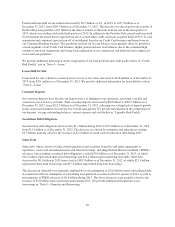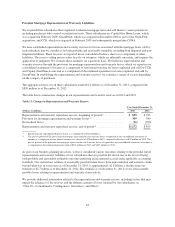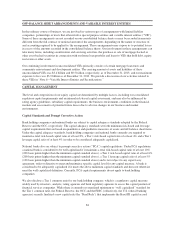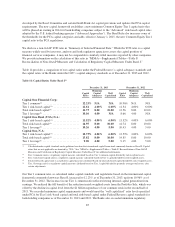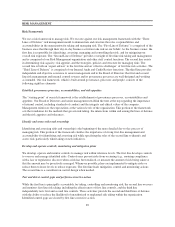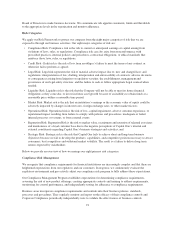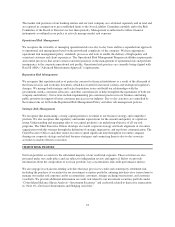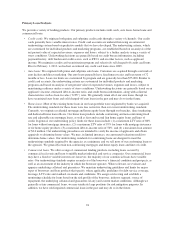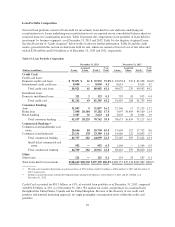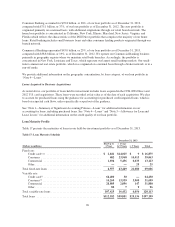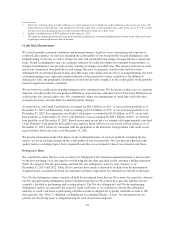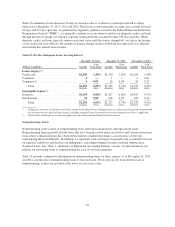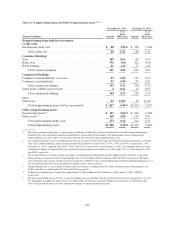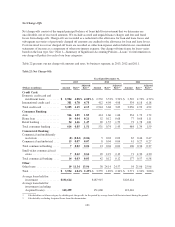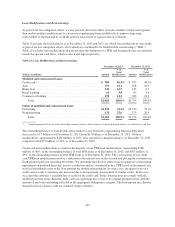Capital One 2013 Annual Report Download - page 112
Download and view the complete annual report
Please find page 112 of the 2013 Capital One annual report below. You can navigate through the pages in the report by either clicking on the pages listed below, or by using the keyword search tool below to find specific information within the annual report.Credit Risk Management
We recognize that we are exposed to cyclical changes in credit quality. Consequently, we try to ensure our credit
portfolio is resilient to economic downturns. Our most important tool in this endeavor is sound underwriting,
using what we deem to be conservative assumptions. In unsecured consumer loan underwriting, we generally
assume that loans will be subject to an environment in which losses are higher than those prevailing at the time of
underwriting. In commercial underwriting, we generally require strong cash flow, collateral and covenants and
guarantees. In addition to sound underwriting, we continually monitor our portfolio and take steps to collect or
work out distressed loans.
Our credit policies establish standards in five areas: customer selection, underwriting, monitoring, remediation,
and portfolio management. The standards in each area provide a framework comprising specific objectives and
control processes. These standards are supported by detailed policies and procedures for each component of the
credit process. Starting with customer selection, our goal is to generally provide credit on terms that generate
above hurdle returns. We use a number of quantitative and qualitative factors to manage credit risk, including
setting credit risk limits and guidelines for each of our lines of business. We monitor performance and forecasts
relative to these guidelines and report results and any required mitigating actions to appropriate senior
management committees and our Board of Directors.
Legal Risk Management
The General Counsel provides legal evaluation and guidance to the enterprise and business areas and partners
with other risk management functions such as Compliance and Internal Audit. This evaluation and guidance is
based on an assessment of the type and degree of legal risk associated with the internal business area practices
and activities and of the controls the business has in place to mitigate legal risks.
Liquidity Risk Management
We seek to mitigate liquidity risk strategically and tactically. From a strategic perspective, we have acquired and
built deposit gathering businesses and significantly reduced our loan to deposit ratio. From a tactical perspective,
we have accumulated a sizeable liquidity reserve comprising cash, high-quality, unencumbered securities, and
committed collateralized credit lines. This combination of funding and liquidity sources facilitates a diverse
access to multiple markets and liquidity sources.
We assess liquidity strength by evaluating several different balance sheet metrics under severe stress scenarios to
ensure we can withstand significant funding degradation in both idiosyncratic and market wide liquidity stress
scenarios. Management reports liquidity metrics to appropriate senior management committees and our Board of
Directors no less than quarterly. We continuously monitor market and economic conditions to evaluate emerging
stress conditions with assessment and appropriate action plans in accordance with our Liquidity Contingency Plan.
Market Risk Management
We recognize that interest rate and foreign exchange risk is inherent in the business of banking due to the nature
of the assets and liabilities of banks. Banks typically manage the trade-off between near-term earnings volatility
and market value volatility by targeting moderate levels of each. In addition to using industry accepted
techniques to analyze and measure interest rate and foreign exchange risk, we perform sensitivity analysis to
identify our risk exposures under a broad range of scenarios. Investment securities and derivatives are the main
levers for the management of interest rate and foreign exchange risk.
We manage market risk exposure, which is principally driven by balance sheet interest rate risk, centrally and
establish quantitative limits to control our exposure. Market risk is inherent in the financial instruments
associated with our business operations and activities, including loans, deposits, securities, short-term
borrowings, long-term debt and derivatives.
92


